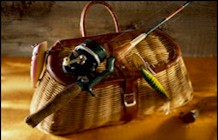
Strawberry fishing calendar
January–March
Strawberry provides excellent ice fishing during the period from ice
formation through the first part of March. March ice fishing success
typically declines, but anglers who move over the deeper water areas
offshore continue to take cutthroat trout. Anglers report good success
fishing with chartreuse grub-type jigs or foxy jigs tipped with meal
worms, night crawlers or power bait. Fish are also commonly taken with
dead minnows. It is important to fish within 1–2 feet of the bottom
during the winter period.
April
April is usually characterized by transition ice conditions, and
fishermen have difficulty in reaching the fish. During years when the
ice comes off early, float tube fishing can be good, but often the fish
do not put up a lively fight due to the extremely cold water conditions.
May
Ice-off usually occurs between May 10 and 15 on normal years.
Post-ice-off is the best time of the year to fish, as large cutthroat
and rainbows move into the warming shallow waters and cruise the
shoreline to feed on leeches, scuds, and snails. Anglers have good
success fly fishing with the typical dark colored leech patterns, and
casting black marabou or grub-type jigs toward the shore. This period
lasts only about two weeks until the spring overturn when the reservoir
water mixes from top to bottom, and the fish scatter widely. In
addition, the larger cutthroat spawners begin searching out spawning
tributaries, and are not interested in feeding.
June
June fishing can be good, but can also be frustrating because the
cutthroats move offshore and scatter throughout the water column, or
ascend the tributaries to spawn. Zooplankton and midges are very
abundant, and the fish are well fed. During the last several years of
high water conditions, worms have become an important part of the trout
diet during this time as well. The cutthroat spawn continues through the
last week in June or first week of July. Fly fishermen typically report
good success fishing with scud or damselfly patterns during this time of
the year.
July–August
Warming surface waters during July and August force the cutthroats to
the deeper open water of the reservoir or to areas influenced by springs
or stream flow. Anglers should use leaded lines or down riggers to get
down to the cutthroat at this time. Depending on weather patterns,
surface waters during the first two weeks of July can reach temperatures
as high as 71°F, which are the warmest of the year. Rainbow tend to
remain in weedbed areas, even during the warm summer months. Rainbow
fishermen should anchor in the shallows and cast power bait, or work
along the edges of the vegetation with marabou jigs or grubs. Fly
fishermen report good catches of rainbow by casting scud, leech or
damselfly imitations on sinking lines in the vicinity of weedbeds. July
and August can be the best times to fish for kokanee salmon. The trick
to catching kokanee is finding the schools, and getting the terminal
gear down to them with leaded lines or down riggers. Kokanee are
typically located at depths of 20–40 feet, and strike a variety of
flashy lures such as needlefish or teasers. Trolling with pop gear or
dodgers attached to the line or down rigger also adds to the attraction.
Many kokanee anglers also use a snubber to prevent the hook from tearing
through the soft tissue of the mouth. Anglers wishing to release their
fish during the summer months should avoid the use of bait or
combination bait rigs. Fish are stressed by warm water conditions, and
release mortalities are higher than at any other time of the year.
September–October
September and October are excellent months to fish for cutthroat.
Cutthroat tend to be cold water feeders, and a variety of fishing
techniques are effective during the fall. Cutthroat are taken in both
deep and shallow waters. Fishing with rapalas, flatfish, Strawberry
wobblers or other fish imitations are particularly effective during this
time of year.
November
Fishing during November can be unpredictable, and is greatly influenced
by the weather. During most years, the boat ramps remain open through
mid-month, and fishing success can be good. November seems to be an
especially popular month for float tubers, who report good success
fishing with purple and black leech patterns until ice-up.
December
At the high reservoir levels we have seen of late, ice forms by about
December 15, but good ice is not common until the end of the month. Safe
ice does not typically form on the Soldier Creek side until about
mid-January. Be sure to wait until there is a good six inches before
venturing out onto the surface of the reservoir.
| Directions:
Strawberry Reservoir is located 23 miles southeast of Heber City,
Utah on US Highway 40. Major improved access routes to the
reservoir include the West Side Road [FS Road 131], Soldier Creek
Marina road, and the Soldier Creek dam road. There are four paved
boat ramps at the reservoir including Strawberry Bay Marina,
Renegade, Soldier Creek Marina, and Aspen. For campground
reservations call the National Recreation Reservation Service toll
free at (877) 444-6777. To reserve the group pavilions call MCM at
(435) 548-2554. For other general user information call the USFS
Heber Ranger District at (435) 654-0470 or the USFS Strawberry
Visitor Center at (435) 548-2321.
|
- Recreational
Opportunities
Boating
Camping
Educational
Programs
Fishing
Hiking
Picnic
Water
Sports
Wildlife
Viewing
|


